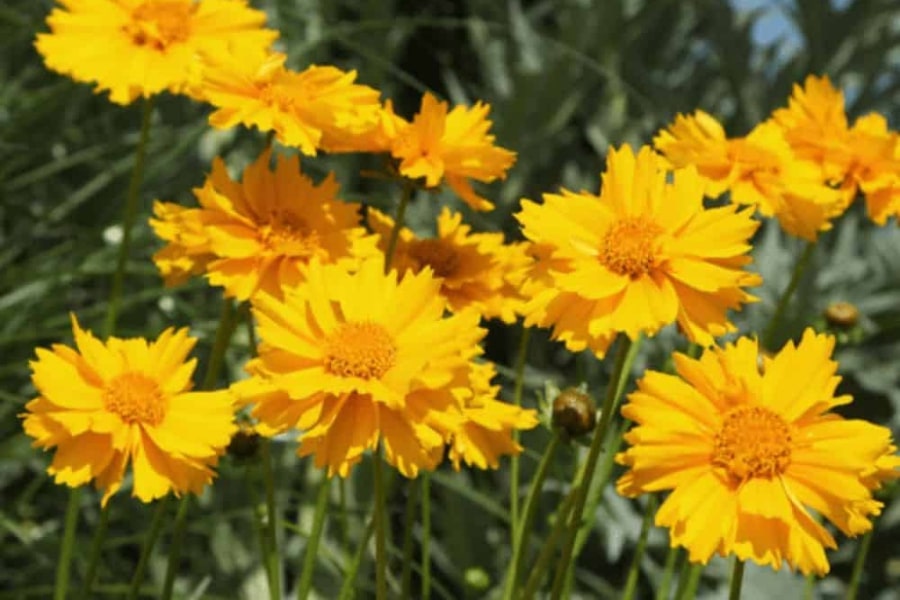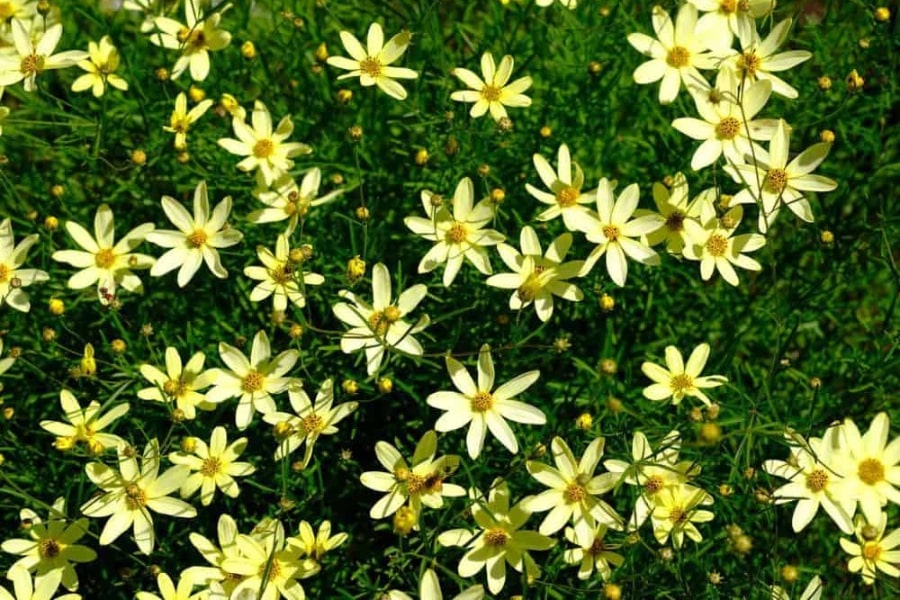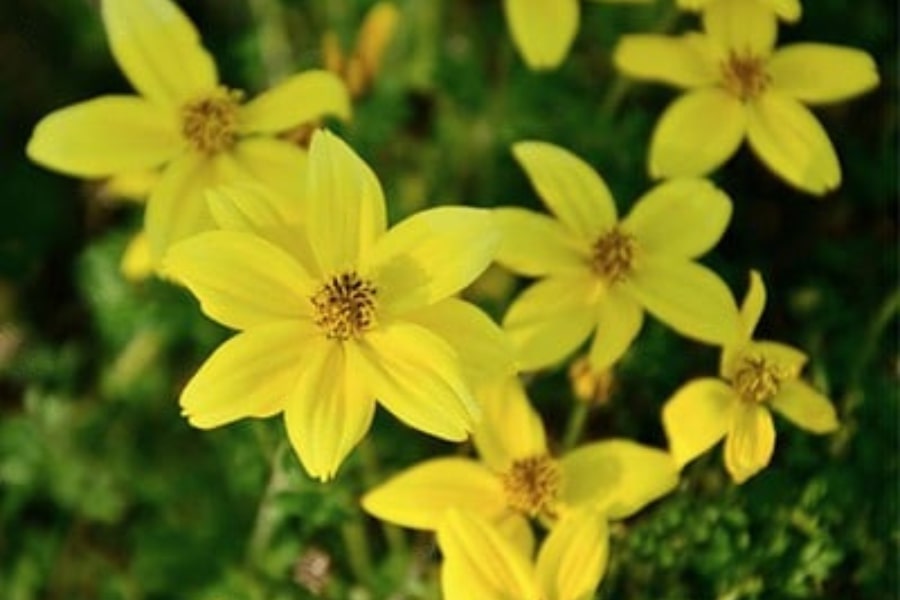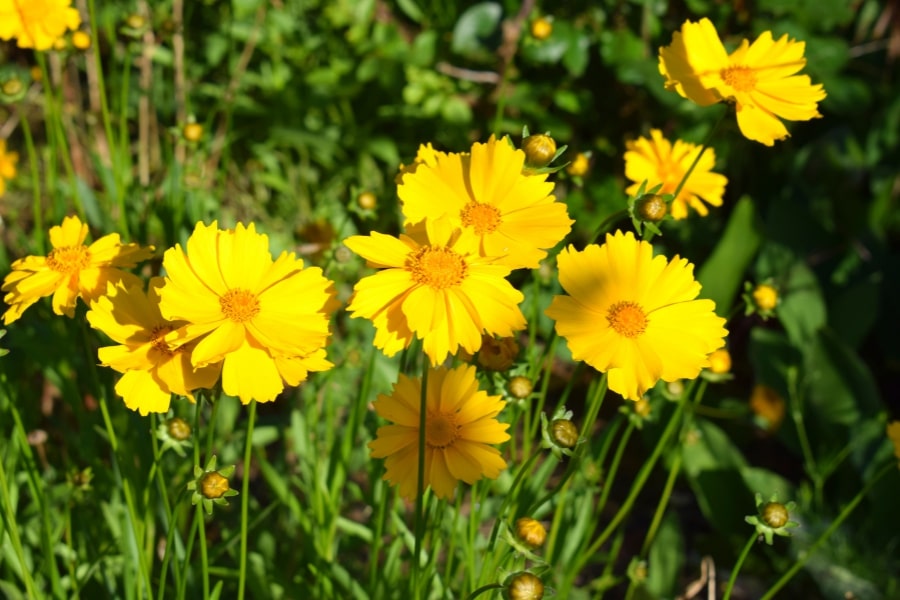Coreopsis, commonly known as Tickseed, is a genus of flowering plants belonging to the Asteraceae family. Coreopsis plants are herbaceous perennials that grow to a height of around 1-2 feet, depending on the species. These beautiful and hardy plants are native to North and South America and are known for their brightly colored, daisy-like flowers that bloom throughout summer.
Coreopsis is extremely popular at Martin Garden Center because of the longevity of the blooms, with some cultivars blooming all season (if deadheaded). There are several types of Coreopsis including auriculata (mouse eared), grandiflora (large blooming), lanceolata (lanceleaf) a native to North America, and verticillata (Threadleaf) that thrive in the Upstate.

Our Selection of Coreopsis
At Martin Garden Center, we grow a variety of 4″ Coreopsis and purchase even more from our vendors. We have Coreopsis stocked from early Spring through late Fall. On occasion, we even have 1-gallon and larger containers. In our perennial section, we try to have 1-2 varieties per color, with the yellow bloomers often having 4-6 different varieties.
We are growing the following varieties in 2025:
- American Dream
- Crazy Cayenne
- Creme Brulee
- Darling Clementine
- Moonbeam
- Nana
- Red Satin
- Uptick Gold & Bronze
- Uptick Red
- Zagreb
We also receive Coreopsis from our vendors throughout the season. Common varieties include Double the Sun, Presto, SunKiss, Tequila Sunrise, and Early Sunrise.
Growing and Caring For Coreopsis
Correopsis thrives when cultivated in environments that cater to its preferred growing conditions. This versatile perennial is adaptable and can be successfully grown in various climates and settings. However, certain conditions ensure optimal growth and a stunning floral display:
1. Sunlight: Correopsis is a sun-loving plant that flourishes in full sunlight. It thrives when exposed to at least six hours of direct sunlight daily. Placing Correopsis in a sunny location allows it to soak in the energy it needs to produce its vibrant flowers and lush foliage.
2. Soil: Well-draining soil is crucial for the health and longevity of Correopsis. Planting it in soil rich in organic matter and allowing water to pass through easily is the best practice. Avoiding waterlogged conditions helps prevent root rot and promotes robust growth.
3. Watering: While Correopsis is relatively drought-tolerant once established, consistent and moderate watering during its early stages of growth is essential to encourage strong root development. After the plant has established itself, it can withstand dry periods without sacrificing vitality.
4. Climate: Correopsis thrives in various climates, temperate and subtropical regions. It is well-suited to gardens that experience distinct seasons, as it can tolerate cold winters and warm summers.
5. Maintenance: Regular deadheading of spent flowers promotes continuous blooming and prolongs the flowering period. Additionally, dividing mature clumps every few years helps rejuvenate the plant and prevent overcrowding.
6. Common Issues & Prevention: Coreopsis tends to be susceptible to powdery mildew so watch closely when the nights are cool for signs of mildew. Copper fungicide is an organic pesticide that helps prevent powdery mildew. Additionally, when blooms are spent, Coreopsis falls into disfavor with customers. However, a simple trimming back will have Coreopsis blooming again in no time. Leave the spent blooms to seed and your plant will remain ugly. In sum, a little hard work can have great benefits when it comes to Coreopsis re-blooms.

Leaves and Flowers
The foliage varies among different species and cultivars, ranging from delicate and feathery to more substantial and deeply lobed. The leaves are typically bright green and possess a lush and healthy appearance, forming attractive mounds or clumps that serve as a lush backdrop for the plant’s colorful flowers.
The hallmark of Coreopsis lies in its flowers, which illuminate the garden with their radiant hues and cheerful demeanor. The flowers resemble delicate daisies and come in various captivating colors, including shades of yellow, gold, orange, and even pink. The blossoms often feature a prominent central disk surrounded by petal-like ray florets. Coreopsis flowers are known for their nectar-rich offerings, making them valuable to pollinator-friendly gardens.

Uses in the Garden
Coreopsis is a fantastic choice for adding long-lasting color and effortless charm to the garden. Its daisy-like blooms bring a cheerful touch, creating a bright and inviting display from late Spring through Fall. Pairing Coreopsis with other sun-loving perennials like Echinacea, Salvia, and Rudbeckia enhances both the visual appeal and pollinator value of a garden space. For a more structured look, plant Coreopsis in masses or drifts to create a bold color statement, or mix it with ornamental grasses for a soft, natural effect.
For gardeners looking to attract butterflies and bees, Coreopsis is a top performer, offering an abundant source of nectar throughout the growing season. It’s also an excellent low-maintenance choice, as it tolerates heat, drought, and poor soils once established. Coreopsis also works well in container gardens, where its compact habit and continuous blooms brighten up patios and porches.

Frequently Asked Questions
Is Coreopsis a Perennial?
Yes, Coreopsis is a perennial plant. Coreopsis, commonly known as tickseed, belongs to the Asteraceae family and is well-regarded for its bright and cheerful flowers. Perennials are plants that live for more than two years, and Coreopsis fits into this category, returning year after year with its colorful blooms.
Is Coreopsis Deer And Rabbit Resistant?
Coreopsis typically falls into the category of plants that are deer and rabbit resistant. These animals tend to avoid coreopsis due to its bitter taste and possibly its slightly fuzzy texture. However, it’s worth noting that no plant is entirely immune to browsing animals, especially if they are hungry or if other food sources are scarce. Occasional monitoring and proactive measures can help ensure its well-being.
Why is Coreopsis Called Tickseed?
Coreopsis is commonly called “tickseed” due to the appearance of its seeds, which are small and somewhat resemble ticks. The name is derived from the Greek words “koris,” meaning bedbug, and “opsis,” meaning resembling. The seeds of Coreopsis plants are typically small and flat and have a shape that can be reminiscent of ticks or bedbugs. This distinctive feature contributed to the common name “tickseed” for this genus of flowering plants.
Is Coreopsis Edible?
While delightful in gardens, Coreopsis is not typically consumed as a food source. Coreopsis lacks widespread culinary use, Unlike other plants in the Asteraceae family, such as lettuce or chamomile. While some indigenous groups have historically used certain species of coreopsis for medicinal purposes, not all species within the genus are safe for consumption, and caution should be exercised. If you’re interested in incorporating edible plants into your garden, many other options are better suited for culinary purposes.
